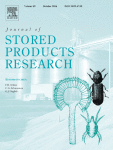Ver ítem
- xmlui.general.dspace_homeCentros Regionales y EEAsCentro Regional Buenos Aires SurEEA BalcarceArtículos científicosxmlui.ArtifactBrowser.ItemViewer.trail
- Inicio
- Centros Regionales y EEAs
- Centro Regional Buenos Aires Sur
- EEA Balcarce
- Artículos científicos
- Ver ítem
Pest control treatments with phosphine and controlled atmospheres in silo bags with different airtightness conditions
Resumen
La tecnología de bolsas de silo ha sido ampliamente utilizada en Argentina para almacenar granos (por ejemplo, trigo, maíz, cebada, girasol y soja, entre otros) desde mediados de los años noventa. Bolsa de silo son ampliamente considerados
Hermético en el que la fumigación con PH3 se implementa con frecuencia para el control de plagas. Sin embargo,no hay suficiente información sobre la posible hermeticidad de las bolsas de silo y cómo podría afectar el
[ver mas...]
La tecnología de bolsas de silo ha sido ampliamente utilizada en Argentina para almacenar granos (por ejemplo, trigo, maíz, cebada, girasol y soja, entre otros) desde mediados de los años noventa. Bolsa de silo son ampliamente considerados
Hermético en el que la fumigación con PH3 se implementa con frecuencia para el control de plagas. Sin embargo,no hay suficiente información sobre la posible hermeticidad de las bolsas de silo y cómo podría afectar el desempeño de los tratamientos de fumigación y atmósfera controlada. En este estudio, una prueba de decaimiento de presión (PDT) para caracterizar el nivel de hermeticidad de las bolsas de silo establecidas siguiendo diversos procedimientos
[Cerrar]
The silo bag technology has been extensively used in Argentina for storing grains (e.g. wheat, corn, barley, sunflower and soybean among others) since the mid-1990s. Silo bag are widely considered a hermetic storage system in which PH3 fumigation is frequently implemented for pest control. However, there is insufficient information regarding the potential airtightness of silo bags and how it could affect the performance of fumigation and controlled
[ver mas...]
The silo bag technology has been extensively used in Argentina for storing grains (e.g. wheat, corn, barley, sunflower and soybean among others) since the mid-1990s. Silo bag are widely considered a hermetic storage system in which PH3 fumigation is frequently implemented for pest control. However, there is insufficient information regarding the potential airtightness of silo bags and how it could affect the performance of fumigation and controlled atmosphere treatments. In this study, a pressure decay test (PDT) was implemented to characterize airtightness level of silo bags set up following various procedures. PH3 fumigation treatments with different dosages and hermeticity levels were conducted, and fumigant concentration was monitored. Controlled atmosphere treatments with carbon dioxide were also implemented in silo bags with different hermeticity levels. Results showed that less than half of the bags tested in the field had a PDT indicated for fumigation (90 s), and that when a bag without thermo sealing was used for fumigation, this treatment failed. However, it was demonstrated that with simple and inexpensive practices silo bags can achieve high enough airtightness conditions to implement successful PH3 fumigation (5 days above 200 ppm with a dosage of 1 g of PH3/m3) and even controlled atmosphere treatments (more than 18 days with CO2 concentration above 70%). This study shows that silo bags could be used as a cost competitive hermetic storage technology for performing controlled atmosphere treatments.
[Cerrar]

Autor
Fuente
Journal of stored products research 69 : 143-151. (October 2016)
Fecha
2016
ISSN
0022-474X
Formato
pdf
Tipo de documento
article
Palabras Claves
Derechos de acceso
Restringido
 Excepto donde se diga explicitamente, este item se publica bajo la siguiente descripción: Creative Commons Attribution-NonCommercial-ShareAlike 2.5 Unported (CC BY-NC-SA 2.5)
Excepto donde se diga explicitamente, este item se publica bajo la siguiente descripción: Creative Commons Attribution-NonCommercial-ShareAlike 2.5 Unported (CC BY-NC-SA 2.5)
Metadatos
Mostrar el registro completo del ítemÍtems relacionados
Mostrando ítems relacionados por Título, autor o materia.
-
Manejo de malezas en el cultivo de pecán
Taiariol, Dario (EEA Bella Vista, INTA, 2022-12-15)Una planta no deseada en un lugar no deseado. No siempre invasivas o salvajes. Efectos adversos de malezas. -En plantas jóvenes: Compite y afecta la disponibilidad de nutrientes, luz y agua y, además, alelopatías. - En ... -
Taladrillo de los forestales: algunos aspectos de su biología, detección y manejo de poblaciones
Cichon, Liliana; Garrido, Silvina Alejandra; Lago, Jonatan; Ahmad, Samir (EEA Alto Valle, INTA, 2013)Megaplatypus sulcatus Chapius, conocido vulgarmente como "barreno" o "taladrillo de los forestales", es un coleóptero que produce severos daños en plantaciones forestales y frutales perforando el tronco de los árboles, ... -
Revalorización del Complejo de Depredadores Polífagos Asociado al Cultivo de los Cítricos, Como Agentes de Control Biológico de Plagas Claves
Bouvet, Juan Pedro (Departamento de Producción Vegetal, Universitat Politècnica de València, 2018-12)Dentro de los enemigos naturales de plagas en los agroecosistemas, los depredadores han sido considerados como uno de los grupos de mayor importancia. Sin embargo, su compleja biología y comportamiento ha obstaculizado en ...

